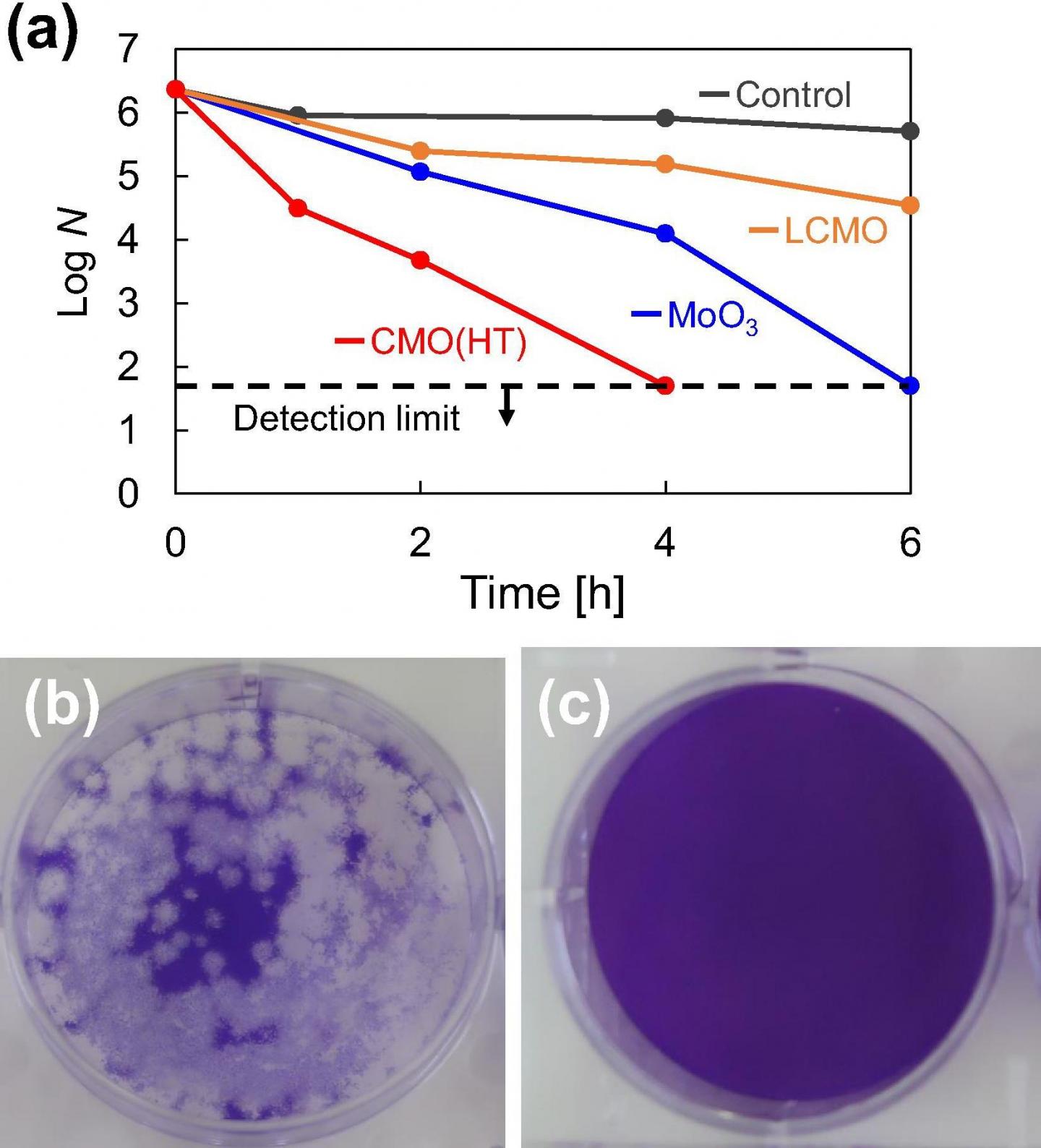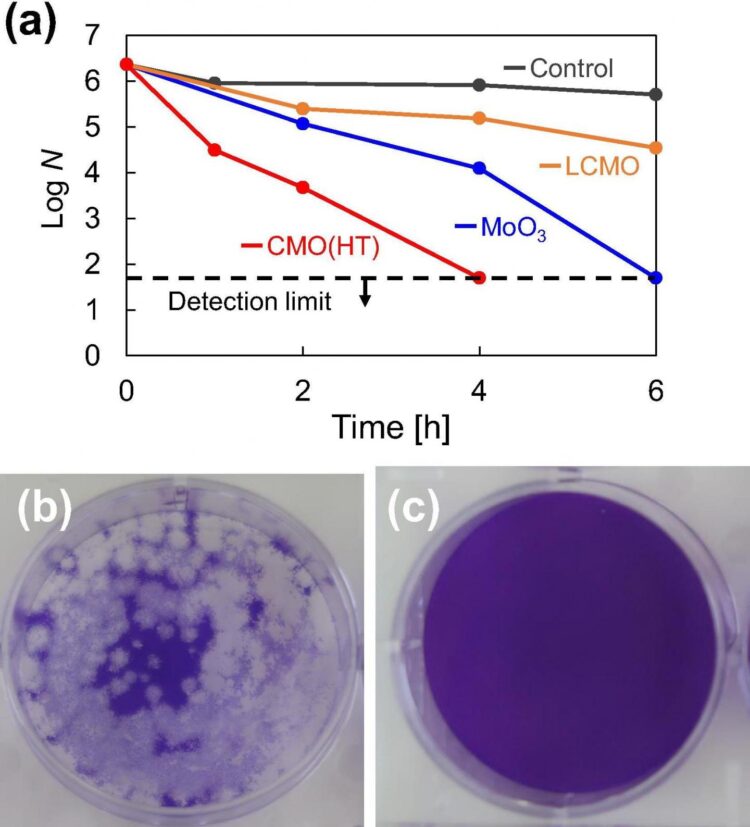New cerium molybdate material could be a game-changer in managing SARS-CoV-2

Credit: Material letters
Researchers at Tokyo Institute of Technology working in collaboration with colleagues at the Kanagawa Institute of Industrial Science and Technology and Nara Medical University in Japan have succeeded in preparing a material called cerium molybdate (γ-Ce2Mo3O13 or CMO), which exhibits high antiviral activity against coronavirus.
The ongoing coronavirus pandemic has highlighted the urgency not only of vaccine development and rollout but also of developing innovative materials and technologies with antiviral properties that could play a vital role in helping to contain the spread of the virus.
Conventional inorganic antimicrobial materials are often prepared with metals such as copper or photocatalysts such as titanium dioxide. However, metal-based materials can be prone to corrosion, and the effects of photocatalysts are usually limited under dark conditions.
Now, a research team led by Akira Nakajima of Tokyo Institute of Technology’s Department of Materials Science and Engineering proposes a new type of an antiviral material that can overcome these drawbacks. The team successfully combined a relatively low-cost rare earth element cerium (Ce) with molybdenum (Mo), which is well known for its antibacterial effects, to prepare two types of cerium molybdate (Ce2Mo3O12 and γ-Ce2Mo3O13) in powder form.
Both powders exhibited antiviral activity against bacteriophage Φ6[1]. Notably, γ-Ce2Mo3O13 also exhibited high antiviral activity against SARS-CoV-2, the virus that causes COVID-19.
The researchers infer that an effective combination of cerium with the molybdate ion as well as the specific surface area[2] are key factors contributing to the observed antiviral activity.
The study builds on earlier work led by Nakajima which demonstrated the antiviral activity of a material named LMO (La2Mo2O9), composed of lanthanum (La) oxide and molybdenum oxide. LMO’s activity, however, was found to be better against non-envelope-type (bacteriophage Qβ) than against envelope-type (bacteriophage Φ6) viruses. Subsequent tests showed that incorporating cerium into the material to make La1.8Ce0.2Mo2O9 (LCMO) improved antiviral activity against bacteriophage Φ6. It was this remarkable finding that spurred further investigations into cerium molybdates (CMO) as promising materials with high antiviral activity against envelope-type viruses such as influenza and SARS-CoV-2.
To obtain the desired CMO powder samples with an almost single-crystal phase, the team conducted many trial experiments before successfully preparing Ce2Mo3O12 using the polymerizable complex method and γ-Ce2Mo3O13 through hydrothermal processing[3].
If standardized and mass-produced, CMO could be used in a wide range of materials such as resins, paper, thin films and paints. This would open up the possibility of using CMO coatings for high-contact surfaces such as door handles, straps inside vehicles, elevator buttons and escalator belts as well as walls, tiles and windows. Nakajima envisions that materials incorporating CMO could also be used in everyday items such as smartphones and clothing. He notes that applications for eye and face ware such as glasses and masks may take a little longer time to develop, but be on the horizon.
###
Technical terms
[1] bacteriophage Φ6: A member of the virus family Cystoviridae that has the rare distinction of having a lipid envelope. It is thus considered a useful surrogate for enveloped viruses and is often used as a model in studies investigating antiviral activity.
[2] specific surface area: Here referring to the total available surface area for adsorption of the virus.
[3] hydrothermal processing: A method harnessing the chemistry of hot water under pressure that enables effective dissolution, which can yield high-quality inorganic products.
Related links
Living in a world with COVID-19 – Future technology for prevention, diagnosis, and treatment
https:/
Nakajima-Matsushita-Isobe Lab
http://www.
Preparation of hydrophobic La2Mo2O9 ceramics with antibacterial and antiviral properties
https:/
About Tokyo Institute of Technology
Tokyo Tech stands at the forefront of research and higher education as the leading university for science and technology in Japan. Tokyo Tech researchers excel in fields ranging from materials science to biology, computer science, and physics. Founded in 1881, Tokyo Tech hosts over 10,000 undergraduate and graduate students per year, who develop into scientific leaders and some of the most sought-after engineers in industry. Embodying the Japanese philosophy of “monotsukuri,” meaning “technical ingenuity and innovation,” the Tokyo Tech community strives to contribute to society through high-impact research.
https:/
About Kanagawa Institute of Industrial Science and Technology
We work as a reliable public experimental and research institute, by means of supporting creation of innovation and promoting local industry, science and technology.
About Nara Medical University (NMU)
Located in Kashihara, Nara, the ancient capital of Japan at around 7th century, NMU has opened as a prefectural University since 1948. As one of unique activities, we have been promoting the concept of medicine-based town (MBT), which aims to contribute to future society by medical approach, in order to utilize our knowledge and skills not only for medical practice but also for all things related to industrial creation and regional revitalization.
Media Contact
Emiko Kawaguchi
[email protected]
Related Journal Article
http://dx.





